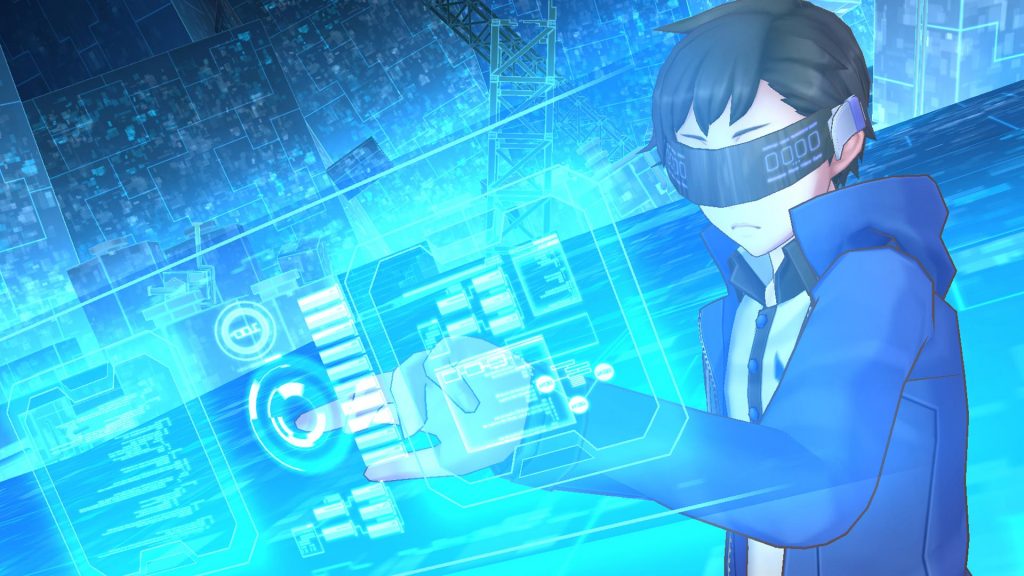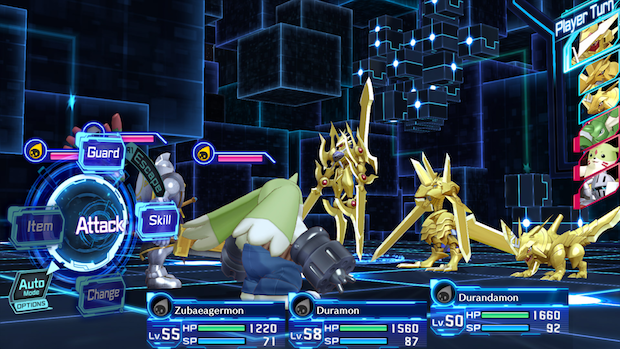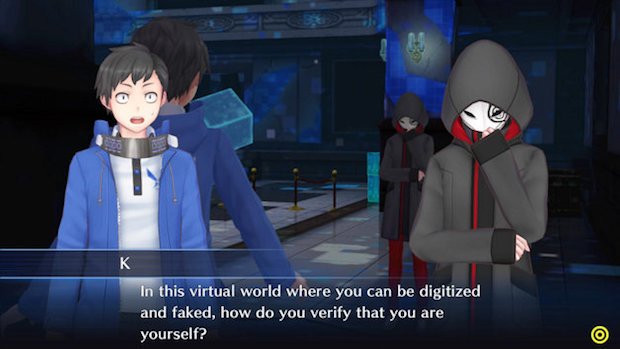
Digimon Story Cyber Sleuth: Hacker’s Memory isn’t shy about the kind of game it is. From the opening crawl where the protagonist waxes poetic about how he isn’t a hero, to the huge reuse of assets throughout the game, Hacker’s Memory is one of those sequels. The “here’s more of the thing you liked” sequels without really striving for anything more.
For good or bad, Digimon Story Cyber Sleuth: Hacker’s Memory is more of what players enjoyed when the 2016 title introduced us to the world of Neo-Shibuya and the virtual internet utopia known as Eden where users enter a physical cyberspace. Taking place at roughly the same time as 2016’s Cyber Sleuth, players take on the role of a self-named rookie in the hacker group Hudie. After their Eden account is stolen from them and he’s framed for a crime he didn’t commit, your hero decides to take matters into his own hands and becomes embroiled in the digital underworld of hackers and Digimon.
"While things might be in different places, the gameplay loop itself is lifted almost completely from the previous title."
The setup makes for a more immediately personal and engaging tale than the previous game, though neither ends up being particularly well told, mostly it seems from a lack of ambition. Hacker’s Memory sticks with the same chapter based progression that Cyber Sleuth had, which itself was written fittingly enough like an ongoing anime serialization, with arcs but little actual substance or growth. Cyber Sleuth had a wacky cast that often felt fairly one note, and Hacker’s Memory is no exception. The fellow hackers of Hudie all follow some fairly bland archetypes which make it feel very stock anime overall. Fun enough JRPG junk food, fitting with the Digimon license.
To this end, while things might be in different places, the gameplay loop itself is lifted almost completely from the previous title. The player will undergo missions with conditions ranging anywhere between running errands in the real world to seeking out abusive hackers within Eden and playing vigilante. These small vignettes play as bite sized episodes of content with their own self-contained plots, and can range in length wildly. The design was clearly considered with handheld play in mind first, but it worked well enough for me on the console by moving fast enough to keep things from becoming stale.
When you aren’t taking on missions to fill time, occasionally the game will take the wheel and have you do a major story event, usually to segue into the next proper chapter and move the overarching plot along. These story missions are where the game usually begins to shine a little brighter, challenging the player with more intricate dungeon crawling instead of how missions usually retread the same handful of areas. A solid 80% of the in game areas are exact copies or at least feel incredibly similar to the preceding game, which does wear for returning players fast even if they haven’t logged into Eden for two years.
"Hacker’s Memory boasts roughly 80 completely new Digimon with the same care to the models that the original set was given. Digimon come in a variety of flavours, with two separate type charts worth keeping track of."
Hacker’s Memory seems occasionally a little split on who it’s for with some of its decisions. There’s just as much tutorializing here as in the first game, and the reliance on reused areas make it seem as if this game is trying to bring in new fans, but then certain plot specifics are just glossed over, perhaps as a knowing wink for the faithful players of the first title and the player is just expected to understand some dungeon mechanics that return from Cyber Sleuth. The loop of taking missions, dungeon crawling and managing Digimon, with one exception discussed in a moment, remains identical and would again, feel very retreaded for the returning player.
Some of the busywork of Cyber Sleuth has been somewhat patched over with Hacker’s Memory, you can get to all the important areas like the Digilab, almost anywhere in Eden or check your missions from the same PC this time instead of running all over. Side Missions will frequently teleport you right to or close to your destination, instead of having you do the legwork. Of course the premise of this game is more immediately grabbing, which also helps keep you engaged as well, and the speediness of the missions and the chapters helps Hacker’s Memory feel like it has a far smoother progression curve overall.
The Digimon battle system is back wholesale from Cyber Sleuth, including incredibly similar if not identical music and most of the models. Hacker’s Memory boasts roughly 80 completely new Digimon with the same care to the models that the original set was given. Digimon come in a variety of flavours, with two separate type charts worth keeping track of. A Digimon can come in four varieties, either Data, Vaccine or Virus, each with a rock, paper, scissors relationship with each other, and Free which grants them neither the pro or con of an allignment. But in addition to this, each has an elemental alignment much like Pokemon, from Fire or Plant, to Dark and Light.
"Digimon will reach certain thresholds and cap out at low levels as more basic Digimon, and then players will have to return to the Digilab and Digivolve them, with different choices being based on the monsters reaching specific criteria."
The battles are very familiar affairs to anyone who’s touched a JRPG in the last 15 years. While the types and elements from above are most immediately reminiscent of Pokemon, the remainder of the battle system is evocative of a Shin Megami Tensei-lite. With your party of three Digimon against the opposing side, you’ll progress in turn based battles where you can attack, use an SP draining special move, usually with an elemental affinity and possible effects or a healing spell, guard or swap out your monsters for others in reserve. The snappiness of the menus is somewhat lost within a post Persona 5 world, and the ability to turn off the attack animations much like Pokemon offers would be welcome to trim the fat. Much like the rest of the game, it’s just so close to what you wanted it to be, so close to those bigger budgeted game that it can grate. But while the minor jank can sometimes annoy, it all still works well enough to not be a mark against the game.
Unlike how Pokemon will automatically evolve when levelled up far enough, the most unique element to the Digimon Story titles is how players get to manage their parties growth. Digimon will reach certain thresholds and cap out at low levels as more basic Digimon, and then players will have to return to the Digilab and Digivolve them, with different choices being based on the monsters reaching specific criteria. The twist then comes in how you can also de-volve your Digimon to previous forms, levelling them up again to learn new skills and with increased stat growths. This balance is needed to reach some of the stronger forms criteria and to round out their battle ability. One stat, Camaraderie, which measures how often you actively fight with a Digimon, returns for this game and remains a massive pain to deal with.
Players first capture a Digimon through encountering it enough times to generate it within the lab, and continue to encounter new species throughout the entire run time of the game, which seems to encourage experimentation and constantly trying out new party members in order to remain flexible. But that Cam stat locks some of the most powerful and iconic Digimon behind it, and flies in the face of the capture mechanic encouraging experimentation by asking you to stick with a core team of six to eight monsters and just bumping them all around their evolutionary flow chart. It’s one piece of weirdness in an otherwise stock stats system and one more piece of jank to Hacker’s Memory.
"All considered, it’s hard to call Digimon Story Cyber Sleuth: Hacker’s Memory either bad or good. It’s just kind of there, as a fairly easy secondary project to keep the fans satiated while the real next game is developed."
One of the very few new elements Hacker’s Memory has to throw out is the Domination battles, which leverages the protagonist being a part of a team well enough and adds a dash of much needed unique flavour that the rest of the game is screaming for. In some ways similar to the Liberation battles of Megaman Battle Network 5, Players take control of multiple members of Hudie and go up against a competing hacker team on a field, with specific movement rules and time limited battles where each side only has a single turn to act. Unlike my obscure example from above, instead of working across a large map towards one goal, Domination Battles are usually about controlling specific spaces and reaching a points total, as well as preventing the enemy from hitting the goal. Because the maps and goals within them are so limited, Domination Battles don’t feel like they’re quite fully fleshed out, and because of that are just fun diversions.
All considered, it’s hard to call Digimon Story Cyber Sleuth: Hacker’s Memory either bad or good. It’s just kind of there, as a fairly easy secondary project to keep the fans satiated while the real next game is developed. While it carries over some of the jank and weirdness that dragged down Cyber Sleuth, it does patch some of it up a bit as well. It’s an easy kind of game to recommend to an RPG fan who has the patience to deal with some of the less polished aspects of Digimon.
This game was reviewed on the PlayStation 4.
Hacker’s Memory has an immediately more engaging plot and some of the choices it makes helps to smooth out the progression from the previous game. Domination Battles add some unique, needed flavour to the game. The quick battle system is just how you remember it, with over 80 new Digimon to use. Growing with your team of Digimon is super satisfying.
Domination Battles are fun but never feel like they’re reaching their potential due to how limited in scope they are. There’s still that same jankiness through the game from strange design decisions, such as CAM being such an important stat and getting in the way of other systems. Reused assets will drag on a returning player.



















